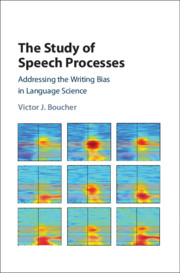Book contents
- The Study of Speech Processes
- The Study of Speech Processes
- Copyright page
- Contents
- Figures
- Tables
- Abbreviations
- Preface
- Introducing a Fundamental Problem of Language Science
- Part I Questions of Ontology: Writing and the Speech–Language Divide
- Part II Questions of Epistemology: The Role of Instrumental Observations
- Part III The Structure of Speech Acts
- 6 Utterances as Communicative Acts
- 7 Relating to Basic Units: Syllable-Like Cycles
- 8 Relating Neural Oscillations to Syllable Cycles and Chunks
- 9 Breath Units of Speech and Their Structural Effects
- Part IV The Processing of Speech Meaning
- References
- Index
7 - Relating to Basic Units: Syllable-Like Cycles
from Part III - The Structure of Speech Acts
Published online by Cambridge University Press: 14 January 2021
- The Study of Speech Processes
- The Study of Speech Processes
- Copyright page
- Contents
- Figures
- Tables
- Abbreviations
- Preface
- Introducing a Fundamental Problem of Language Science
- Part I Questions of Ontology: Writing and the Speech–Language Divide
- Part II Questions of Epistemology: The Role of Instrumental Observations
- Part III The Structure of Speech Acts
- 6 Utterances as Communicative Acts
- 7 Relating to Basic Units: Syllable-Like Cycles
- 8 Relating Neural Oscillations to Syllable Cycles and Chunks
- 9 Breath Units of Speech and Their Structural Effects
- Part IV The Processing of Speech Meaning
- References
- Index
Summary
A critical review of models of speech-motor control serves to illustrate the ongoing problem of elaborating an interface between speech and concepts of phonemes or “syllables” as groups of phonemes.The problem extends to neuro- and psycho-linguistic models. In addressing the issue of“the interface that never was,” several lines of evidence are presented that demonstrate syllable-size cycles as basic sequencing units of articulation, muscle activation, and representation in sequence memory. The evidence also suggests that a conceptualization of speech in terms of linguistic-type+/– features that are taken to be timed in letter-like bundles have oriented models, but fundamentally misrepresent both the timing and the graded control of muscles and articulatory motions. Instrumental records of graded control support coherent syllable-size cycles as basic sequencing units and evidence is discussed with a view on how syllable-internal timing can relate to intrinsic properties of relaxing tissues which do not imply a sequential control of closing and opening motions within a motion cycle.
Keywords
- Type
- Chapter
- Information
- The Study of Speech ProcessesAddressing the Writing Bias in Language Science, pp. 143 - 171Publisher: Cambridge University PressPrint publication year: 2021

